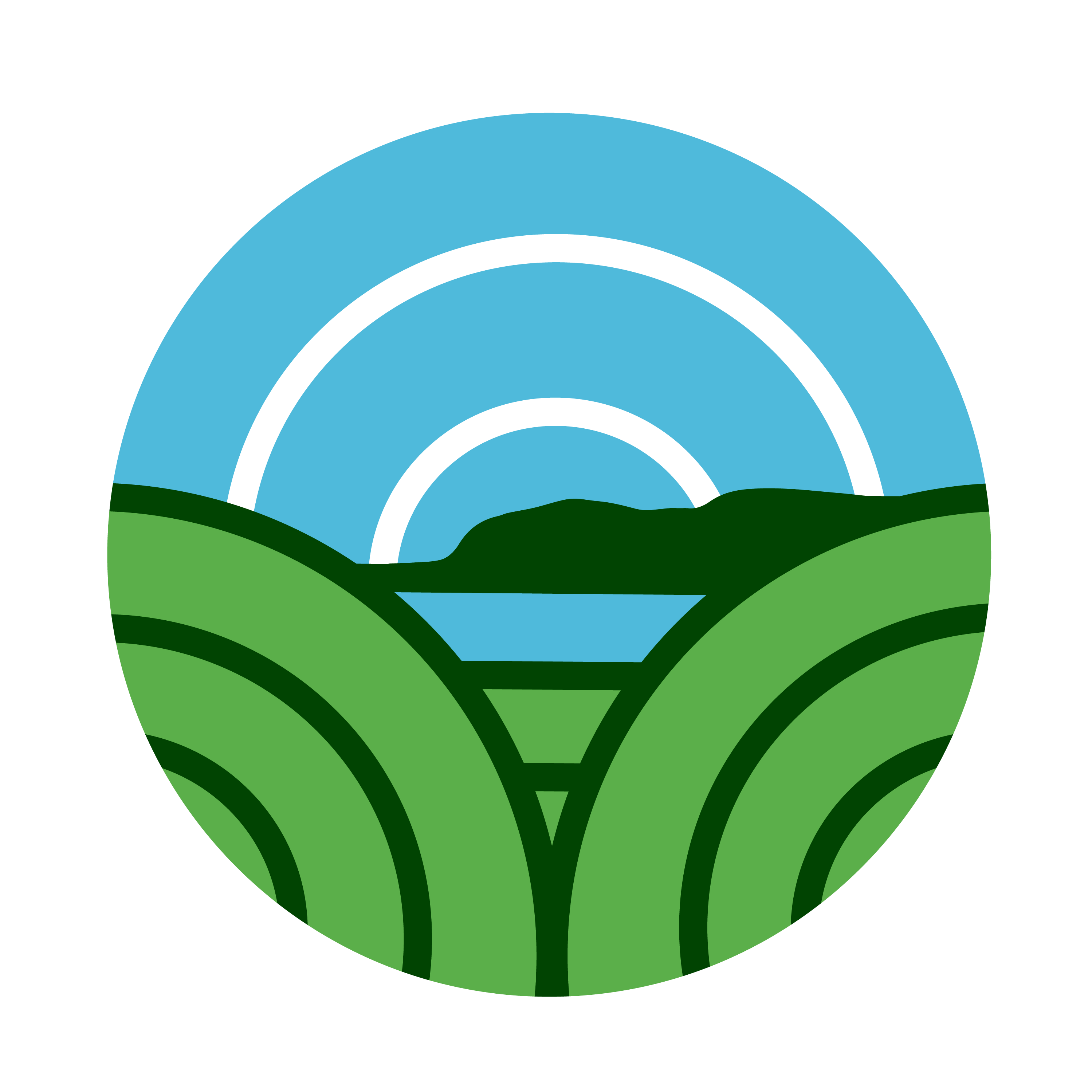Introduction – Farming in the Past
Earliest evidence of man in the Glens was around 7,500 years ago, and of farming around 4,000 BC. Later, possibly from the Bronze Age, a system of landlords and tenants was introduced, and it wasn’t until after the Great Famine and a number of Land Acts that landlords were encouraged to sell holdings to their tenants. Around 1828 some farms in the Glens were divided up by landlord’s, and this continued up to the turn of the 20th century. Tenants were given strips of lands, good and bad, (ladder farms), and most of the family farms in Glenshesk still reflect this today.
We are fortunate in Glenshesk to have several well-known photographic collections of farming in this past of the Glen, principally the Robert John Welch Collection and Fr John McCaughan Collection, who were attracted to this part of Ireland and Glens of Antrim.
Slide Car & Block Wheeled Cart:
Broughmore was a favourite place for the famous photographer, Robert J Welch to visit, and here we have a selection of photographs taken by him on the Brown family farm at Broughmore, Glenshesk. In the first photo you can see a primitive but effective “slide car” which had no wheels (in the foreground), and consisted of simply two wooden poles tied together in a V-shape, and pulled behind a horse.
We can also see a solid wheeled cart, known also as a block-wheeled cart, (no punctures here!). It has of course ancient origins, but was excellent for transporting heavy loads.
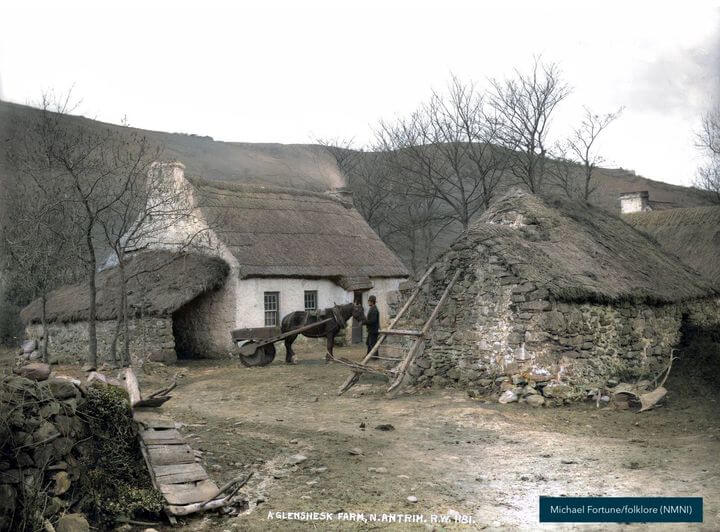



Working Carts & Traps on the Farm:
Carts along with a horse, and sometimes with a donkey, were an essential part of a working farm, both for working on the farm, as well as travelling to and from it. Several working carts on the farm can be seen in the background of the children playing with their wooden cart in this photograph from 1924. They would have been used for a variety of general carrying of goods, tools or produce; it is generally acknowledged that a horse and cart could transport a load of one ton. The wheel consists of the wooden hub, in the centre of which is fitted a piece of cast iron, with a tapering hole which forms the bearing. Around the outside of the hub, twelve square or oblong holes or mortises were cut to accept the spokes.
The spokes were in turn mortised into the fellows, these were semi-circular pieces of wood, usually six in number which fitted together making the complete wheel, a circular iron band or tire was then fitted to the wheel. This skilled job was usually accomplished by the local blacksmith who heated the iron tire to a red hot heat; when metal is heated it expands, so as the tire gets bigger allowing it to be fitted around the wheel. When the tire and the wheel were lined up, the tire was then cooled with water. This contracted the metal rim clamping the whole wheel together. In Glenshesk today you can still find the abandoned metal rims
Traps on the other hand were used for travelling to and from locations, although sometimes if it was just one person who needed to travel, a horse on its own would do the job! The photo attached by Fr John McCaughan is of a horse and trap in Duncarbit Farm Glenshesk, 1921. The horse in the photograph, Troytown, was named after the 1920 Grand National Winner!
Lime Kilns:
Throughout Glenshesk, numerous examples of Lime Kilns can be found dotted across the landscape. Lime has long been used by farmers as fertiliser and in mortar. Kilns were built into the hillside to facilitate the top loading of limestone. A fire of coal or peat was lit inside the kiln and alternative layers of fuel and lime were added continuously for several days. The heat reduced the rock to powder. This was spread on the fields to reduce the acidity of the peaty soils and thus improve the fields of grass and grain.
Lime was also used as a building material for houses and of course to whitewash the front of houses and outbuildings. Lime was quarried locally and commercially at Ballycastle, and if you look closely on the Glenshesk side of Knocklayde at sunrise or sunset, the light and shadow will often highlight the indents where lime was once quarried by local farmers.
Information courtesy of Alan Turner from “The Glens of Antrim”


Boiling Pots:
Here we have a recent unique find in Glenshesk; a “boiling pot” for animal feed in situ. These pots were used in the Glens over a 100 years ago for boiling potatoes, turnip, etc. food for feeding pigs. The first photograph shows, unusually, the boiling pot as it would have been set up, outside in an abandoned farmstead. A crude stone construction is built around it to hold it in place, and space has been provided underneath it for the burning of wood and turf for generating heat. The second photo is of an abandoned boiling pot in the Glen


Potatoes
It is thought that potatoes were introduced to the Glens around the 1600s, and quickly became one of the main crops grown here and across Ireland, as it very much suited the climate. It was one of the main sources of nutrition for the population, which of course led tragically to the Great Irish Famine, due to the populations over reliance of it, which failed when the crop was struck with blight.
Potatoes across the glens were at this time grown in rigs or “lazy beds”, and are seen in this famous photograph taken in Glenshesk of the McAllister sisters setting potatoes taken in the 1920’s by Robert Welch. Techniques such as spadework were described as “common” during the nineteenth century. This usually implied that they were inefficient. In fact, while they were slow and labour intensive, techniques such as spadework or reaping with sickles were very refined. The photograph was probably taken towards the Armoy end of Glenshesk. Photo courtesy of Welch Collection, Ulster Folk & Transport Museum, narrative from “People and the Land” by Jonathan Bell.
It is surprising that many of these lazy beds dug well over a 100 years ago can still be seen in the landscape, particularly caught in the light and shadow of sunrise or sunset. In this unusual photograph taken in the Spring in Glenshesk, we see the Lazy Bed’s shape highlighted by wild bluebells.

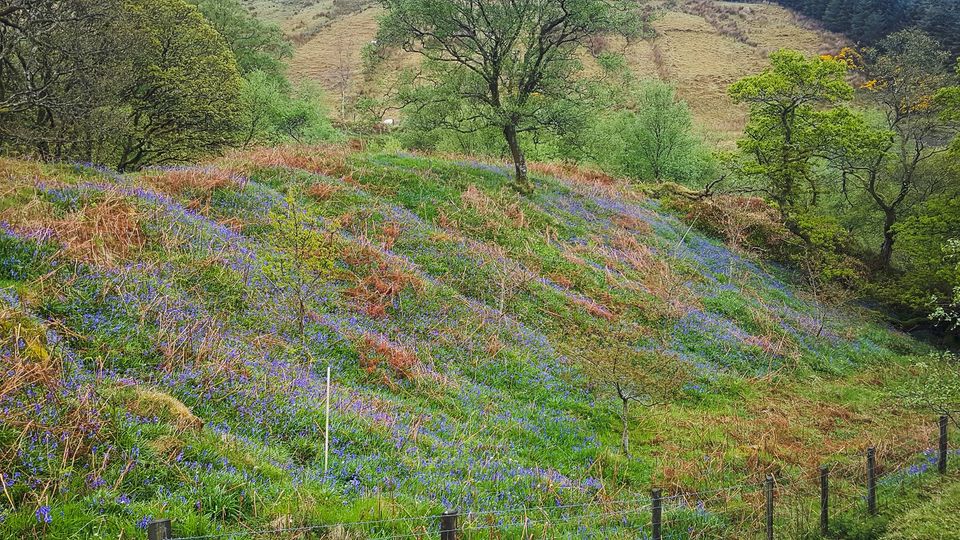
Hay Pake & Stacks:
Here we have two unique photographs. First of all we have Jack Brown in the townland of Drumacullin, Glenshesk, working on a “hay pake”. Jack is putting the finishing touches to the ropes securing the thatch, made of rushes on the pake (pike). The photograph was taken in the 1970’s courtesy of Brian McCaughan.
The second photo titled “Sam shows how to fork”, was taken on the 17th August 1925 of men working on a hay stack in the “Stack Yard”, Duncarbit Form, Glenshesk. At the front of he cart are standing brothers Sean & Kevin McCaughan. Photo – Fr John McCaughan Collection.
Check out the Tab on this Page “Life in the Glens – Farming – Farming in Glenshesk today” to learn more about Hay Pakes/Stacks.

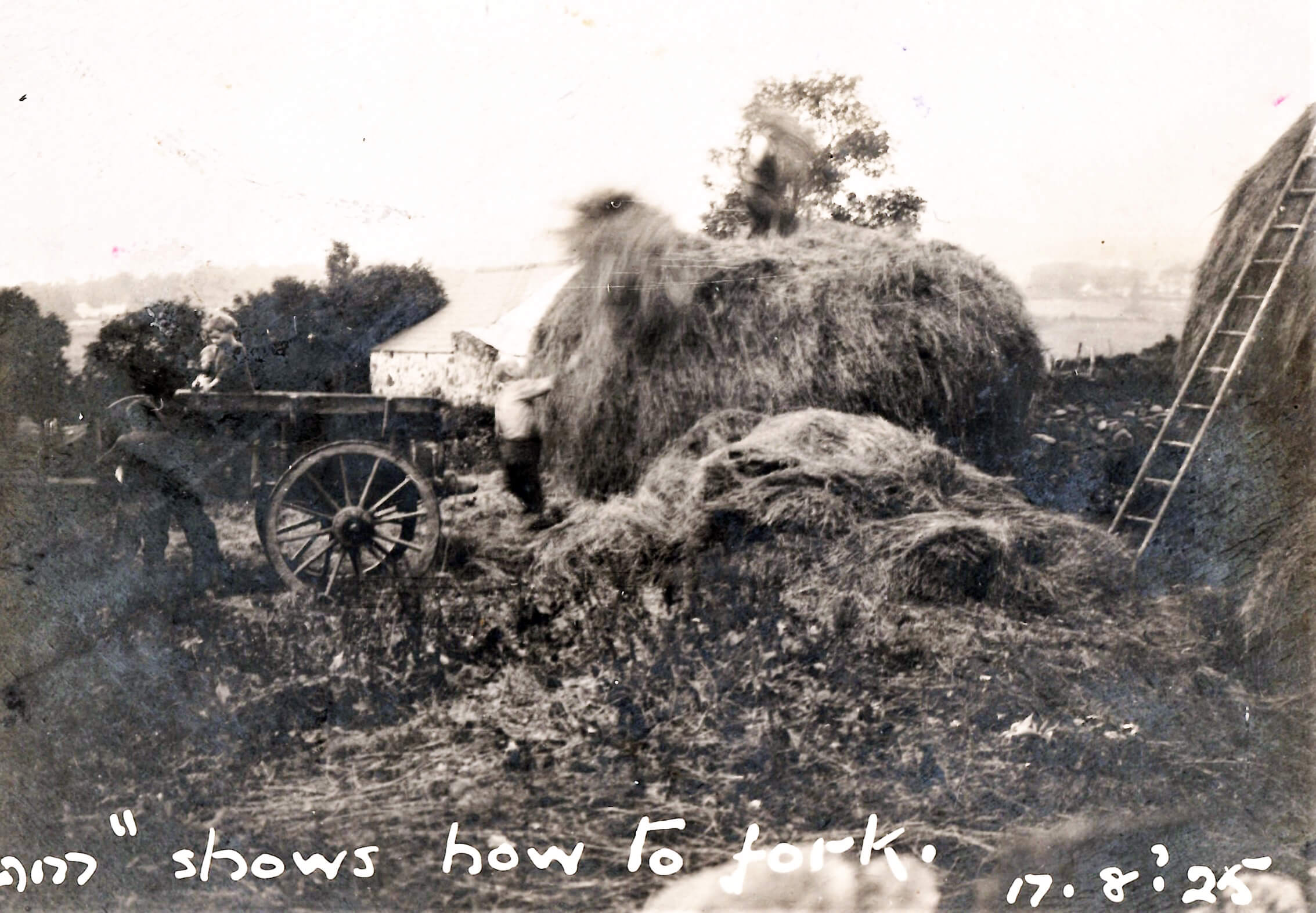
Thrashing Machine & Horsewalks.
This Glenshesk abandoned thrashing machine and a horse walk were made by local manufacturer, H. Kennedy & Sons Ltd from Coleraine. This local firm sold thrashing machines throughout Ireland between 1840-1960. Expensive machinery such as threshers were usually housed in their own outbuildings, and in this case, powered by a horse. Horse-walks were usually installed on the other side of the wall from where the thresher was, directly outside and connected underground to it. It’s unusual to find both the horse-walk and remains of the thresher still in situ, as in this case in an abandoned farmstead in Glenshesk. In many farms in the Glen, you could have two horse walks; one for the farm house for churning butter, and the other attached to a barn for threshing corn and the like.
Horsewalks were also sometimes used to power other farm machinery on the farm. In the link attached, you can see how horewalks actually powered farm machinery



Seed Fiddle & Sewing with a Sheet:
In the first photograph we see local man Hector Devlin, using a seed-fiddle to sow seed in a field in Glenshesk. The person using the fiddle would pull and push the bow as they walked in lines across a field. This unusual piece of farm machinery was quite accurate, and after the field was sowed, it was harrowed using a harrow like the one pictured later on this page. It would be handy if the farmer was already a fiddle player!
A more basic way of sowing seed was using simply a sheet as a bag, as demonstrated by the second photograph taken in Glenshesk in the 1950’s

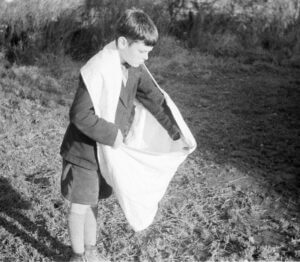
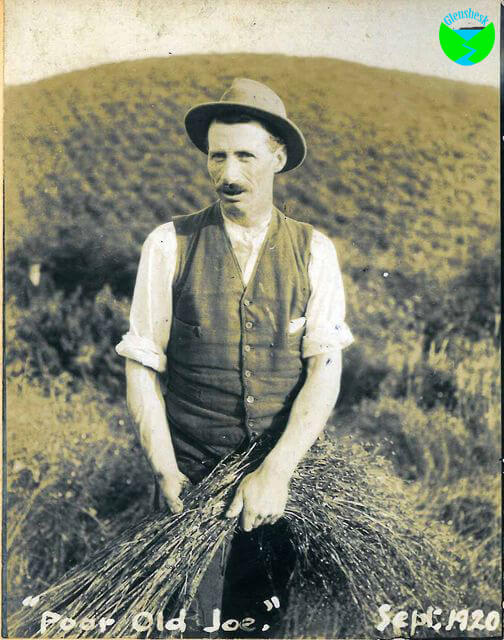
Flax.
Flax was a popular crop in Glenshesk, and we are fortunate to have this and other unique photographs of local farmers working with flax over 100 years ago taken by Fr John McCaughan. This is Joe McBride working at Flax at Loughan, Glenshesk
Flax is believed to have been grown in Ireland since the Bronze age and originally used for making clothes to be later used in the 18th and 19th century for making Irish Linen, which became famous worldwide.
The crop was quite labour intensive starting as a planted crop which had to be sown in very fine harrowed soil. When the crop was ready, it was pulled by hand, and later placed in retting dams by hand; the smell by all accounts was very strong.
Later the crop was removed by hand and stooked for drying, before being delivered by horse and cart to the scutching mill.
Turnip Sower:
Turnip soars like the one shown took the hard work out of sowing the fine seed, by being able to do it more evenly.
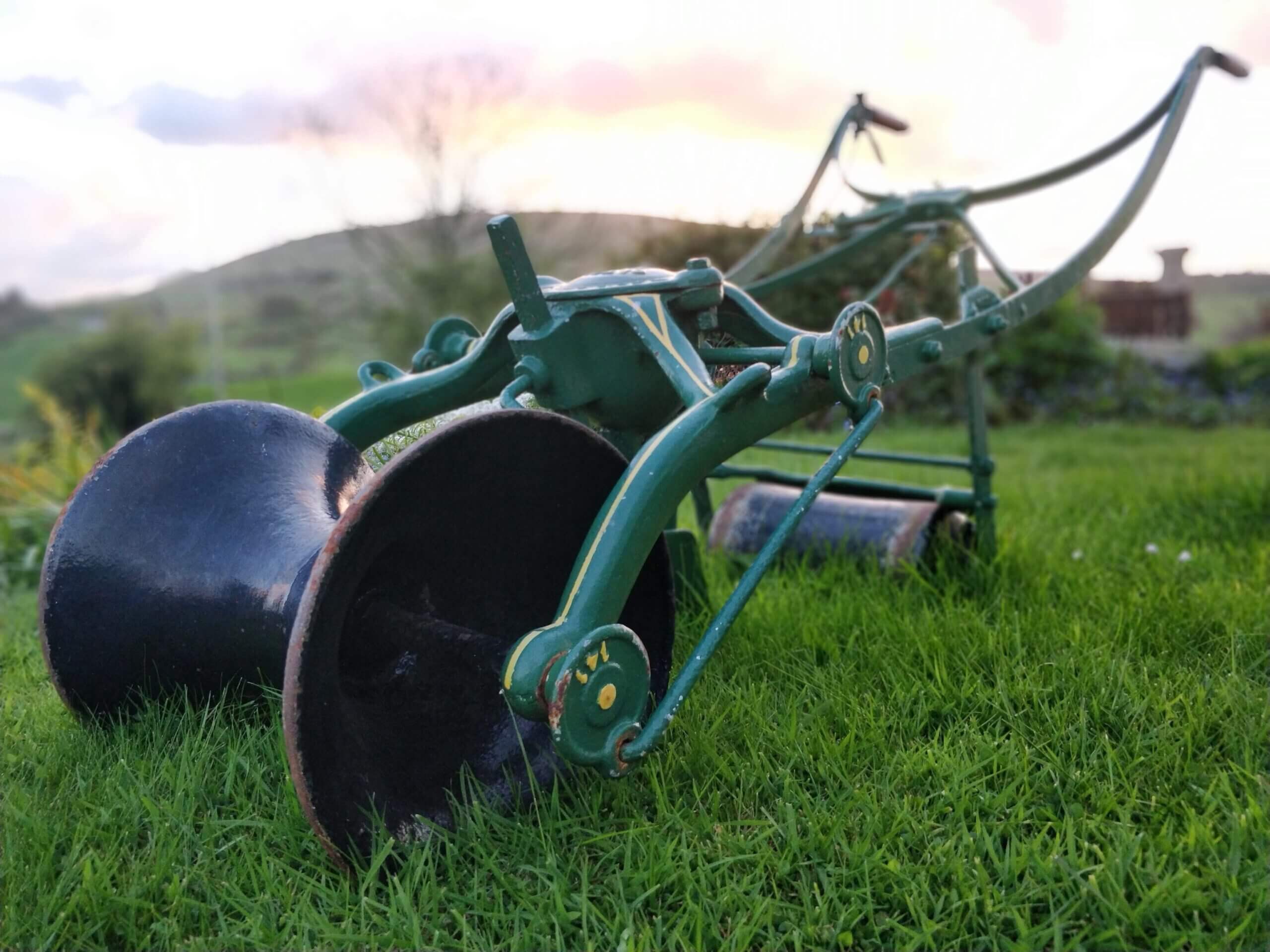
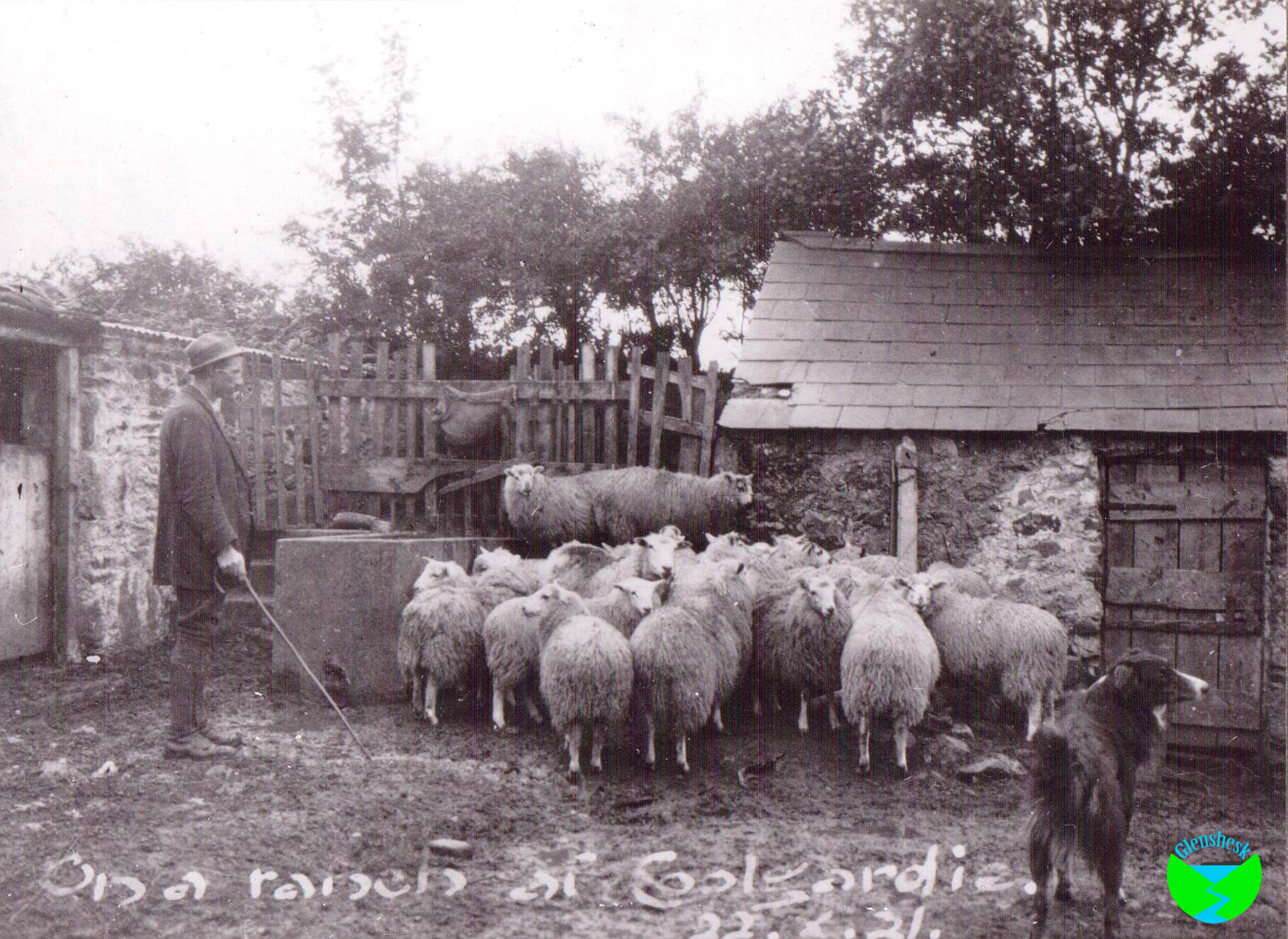
Sheep.
The main type of farming in the Glens of Antrim including Glenshesk, was for many generations the farming of sheep. The hill farms are not really suited for the growing of crops, although silage (grass) and flax was grown, but it is ideal for sheep, particularly the hardier breeds. The most popular breed of sheep was and still is Scottish Blackface. Here we have a great photograph of some crossbred sheep at the McBride farm at Loughan, Glenshesk, taken by Fr John McCaughan. In this old type of sheep dipper, the farmer lifted the sheep up into the dipper, held the sheep for a few seconds in it, and then let the sheep walk back up to a pen to dry out.
The busiest times of the year outside of making hay was the lambing, and then after that, the clipping of sheep. Apart from the selling of wool, which was a popular commodity then (how trends haver changed), was the selling of lambs and sheep at local livestock marts at either Armoy or Ballycastle including the Lammas Fair. Sheep also provided fresh meat for the family.
Check out “Farming” – “Farming in Glenshesk Today” tab in menue for more about sheep
Sheep Pens:
With sheep farming being the main type of farming in Glenshesk, on most farms you will at least come across one if not two sets of sheep pens. The sheep were brought here to be clipped, dosing, for separating, etc. In the Glens sheep pens are often just called the “dipper”, as most contain a dipper, a sunken bath area for sheep to be dipped.
One interesting first in the glens and possibly in N.Ireland was the “sheep shedder” to be found in Duncarbit Farm’s sheep pens. The late Kevin McCaughan recounted that one of his ancestors returning from Australia, introduced the idea of having a sheep shedder (race) in the pens, as he saw it work very effectively when working in Australia. This possibly links into Patrick McCaughan who was born in Duncarbit in 1844, and left in his teens for Australia, and after several years ended up working for one of the largest and wealthiest sheep farmers in New Zealand, “Big Clarke”; it may have been him or one of his descendants that returned with the idea at a later date. A sheep shedder/race is a “V” shaped pen, where the sheep are chased into the open end, and then at the point there is a swinging gate which is used to separate the sheep into two separate pens. The idea is very simple, but can make the work of separating sheep very easy. When the shedder was installed, it created a lot of interest at the time from the farming community from across the glens, as well as from the Ministry of Agriculture, who visited the farm This resulted in the simple structure becoming an essential part of most sheep farms across the north and further afield.
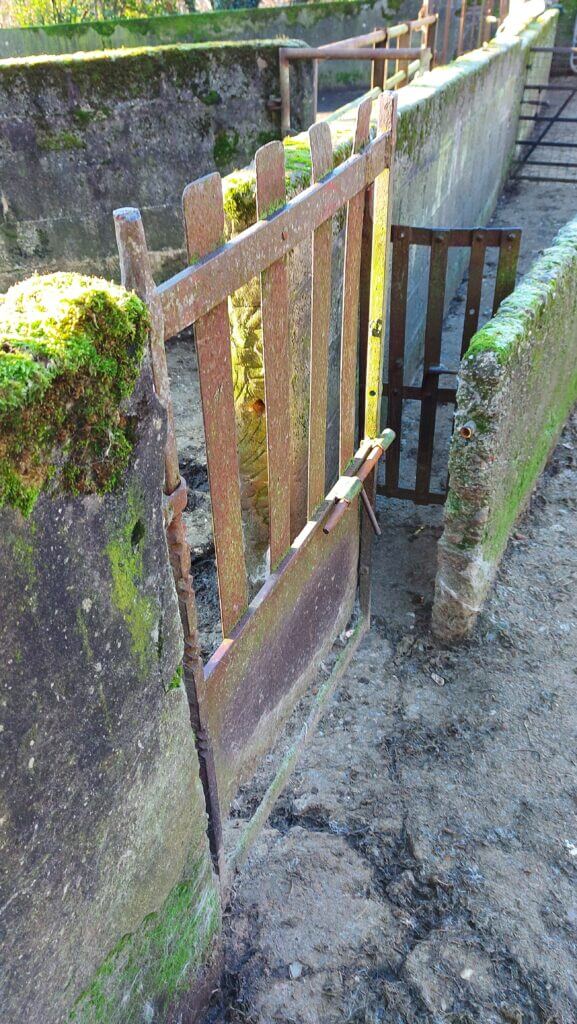



Dosing Gun:
Part of looking after sheep is of course looking after their general health. We are familiar with the dosing gun used to dose sheep today, however, here we also have two very crude measuring devices used for dosing livestock in the past in Glenshesk. The earliest is a brass pipe that was simply submerged, (sealed end first) into a bucket of dosing liquid, and when lifted out, the farmer had the exact measure. The excess liquid poured out from the hole on its side. The second photo is of its replacement, a glass dosing measure, in this case with branding from Coopers, one of the main suppliers of veterinary drugs. The final picture is of a modern dosing gun, as used by farmers in the Glen, although this has been superseded by the use of pour-on’s.


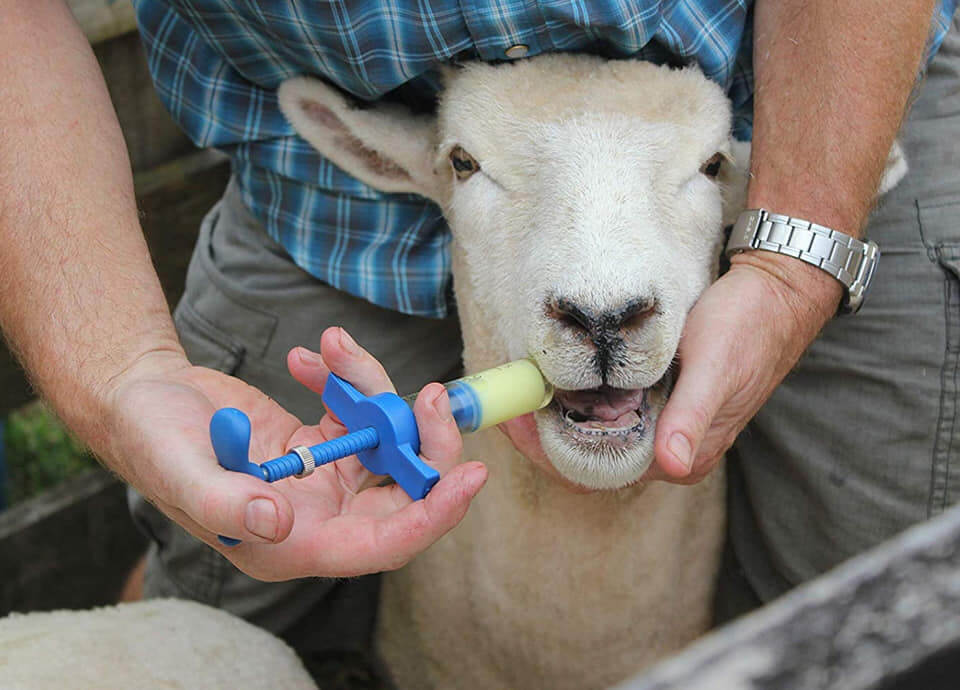
Spring Grubber
A spring grubber like the abandoned one shown in this photograph in Glenshesk, was used to break up the soil before it was to be ploughed. It has spikes underneath which break up the soil and was pulled by a horse.

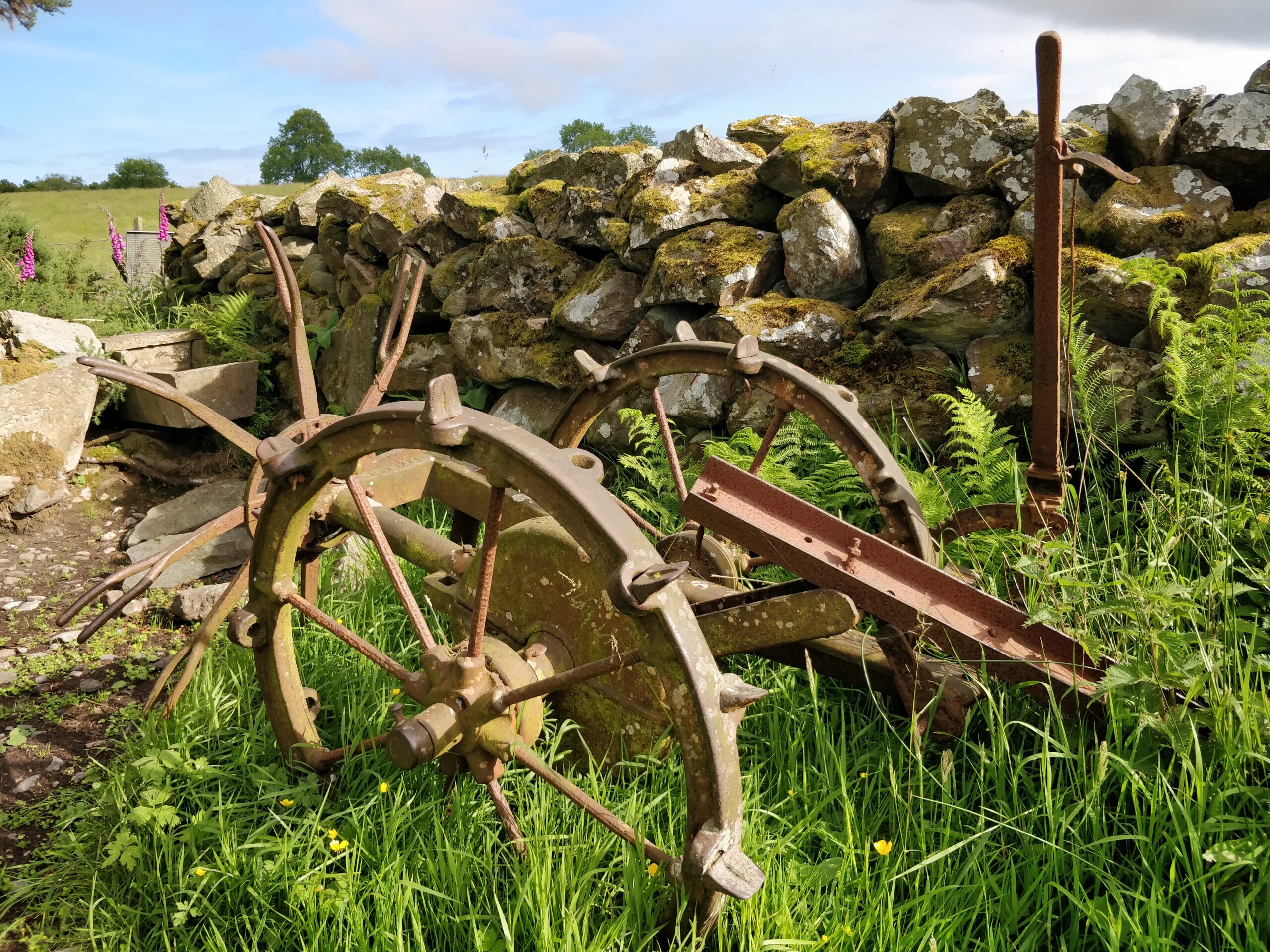
Potato Digger:
The photograph attached is of an old horse drawn potato digger (or spinner) and was drawn by horse and driven by a ground drive. It works by a flat piece of metal which runs horizontal to the ground lifting the potatoes up, and a large wheel with spokes on it called a reel pushing the clay and potatoes out to the side. The potatoes are then gathered by hand, placed into containers and transported from the field back to a farm shed.
The potato digger’s have become obsolete because modern potato harvesting equipment eliminates manual gathering of potatoes and leaves fewer potatoes in the soil
Harrow
A Harrow is an implement for breaking up and smoothing out the surface of the soil. In this way it is distinct in its effect from the plough, which is used for deeper tillage. Harrowing is often carried out on fields to follow the rough finish left by ploughing. The purpose of this harrowing is generally to break up clods (lumps of soil) and to provide a finer finish, a good tilth or soil structure that is suitable for seedbed use. Coarser harrowing may also be used to remove weeds and to cover seed after sowing. Harrows differ from cultivators in that they disturb the whole surface of the soil, such as to prepare a seedbed, instead of disturbing only narrow trails that skirt crop rows (to kill weeds).
There are different types of harrows including the disc harrow and spike harrow, shown in the photographs attached of two abandoned models in Glenshesk. Harrows were originally drawn by animals, such as horses, donkeys, or in some times and places, by manual labourers. In modern practice they are almost always tractor-mounted implements, either trailed after the tractor by a drawbar or mounted on the three-point hitch.
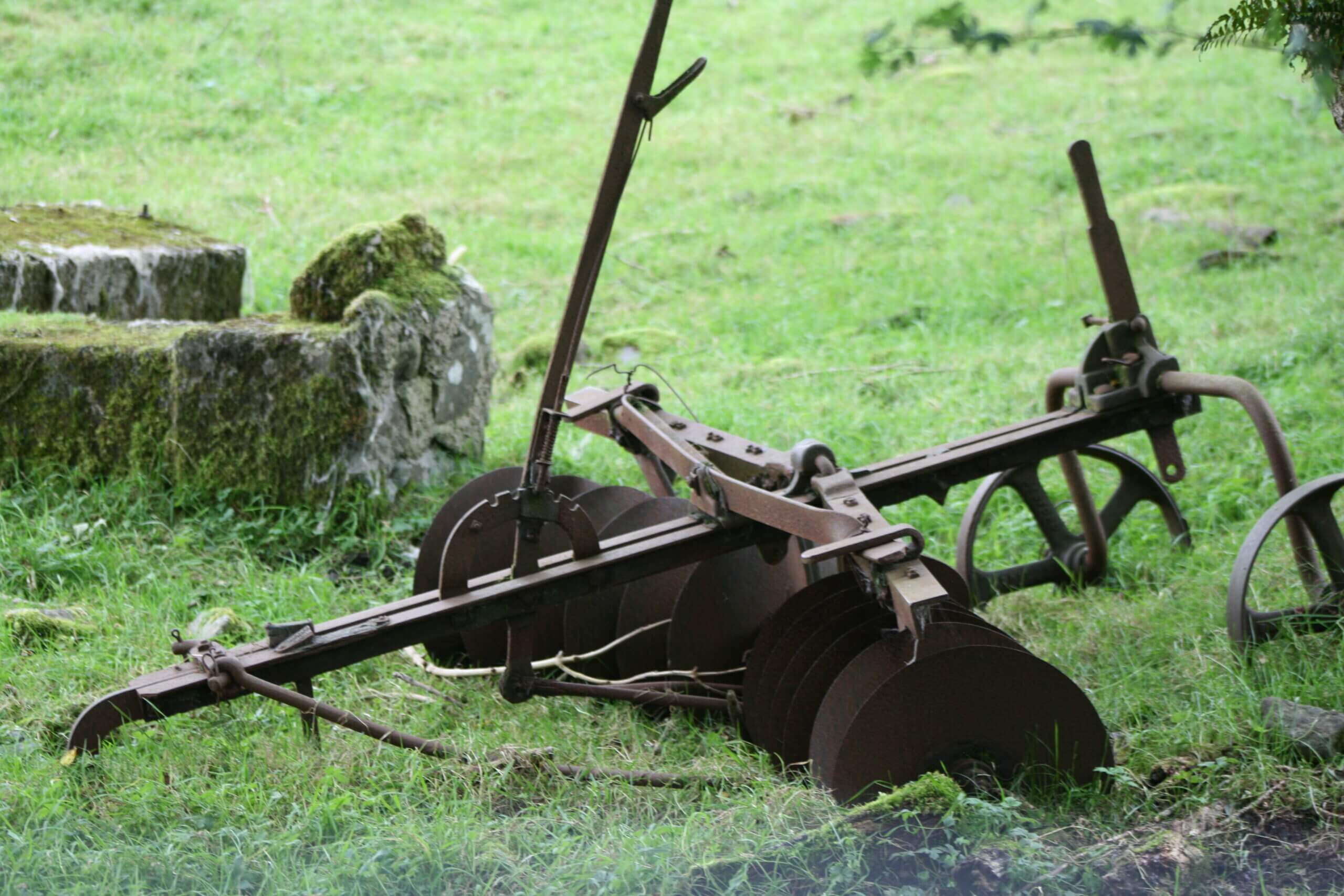

Corn Binder:
Here we have a splendid photograph of Declan McCaughan, Brackney, in a field of corn (oaks) with a binder, with Glenshesk perfectly framed in the background.
In addition to cutting the small-grain crop, a binder (or reaper-binder) also ‘binds’ the stems into bundles or sheaves. These sheaves are usually then ‘shocked’ into A-shaped conical stooks, resembling small tipis, to allow the grain to dry for several days before being picked up and threshed (separate the grain or seeds from a cereal plant).
For Hay and Silage Making, check out the tab “Farming” – “Farming in Glenshesk today”

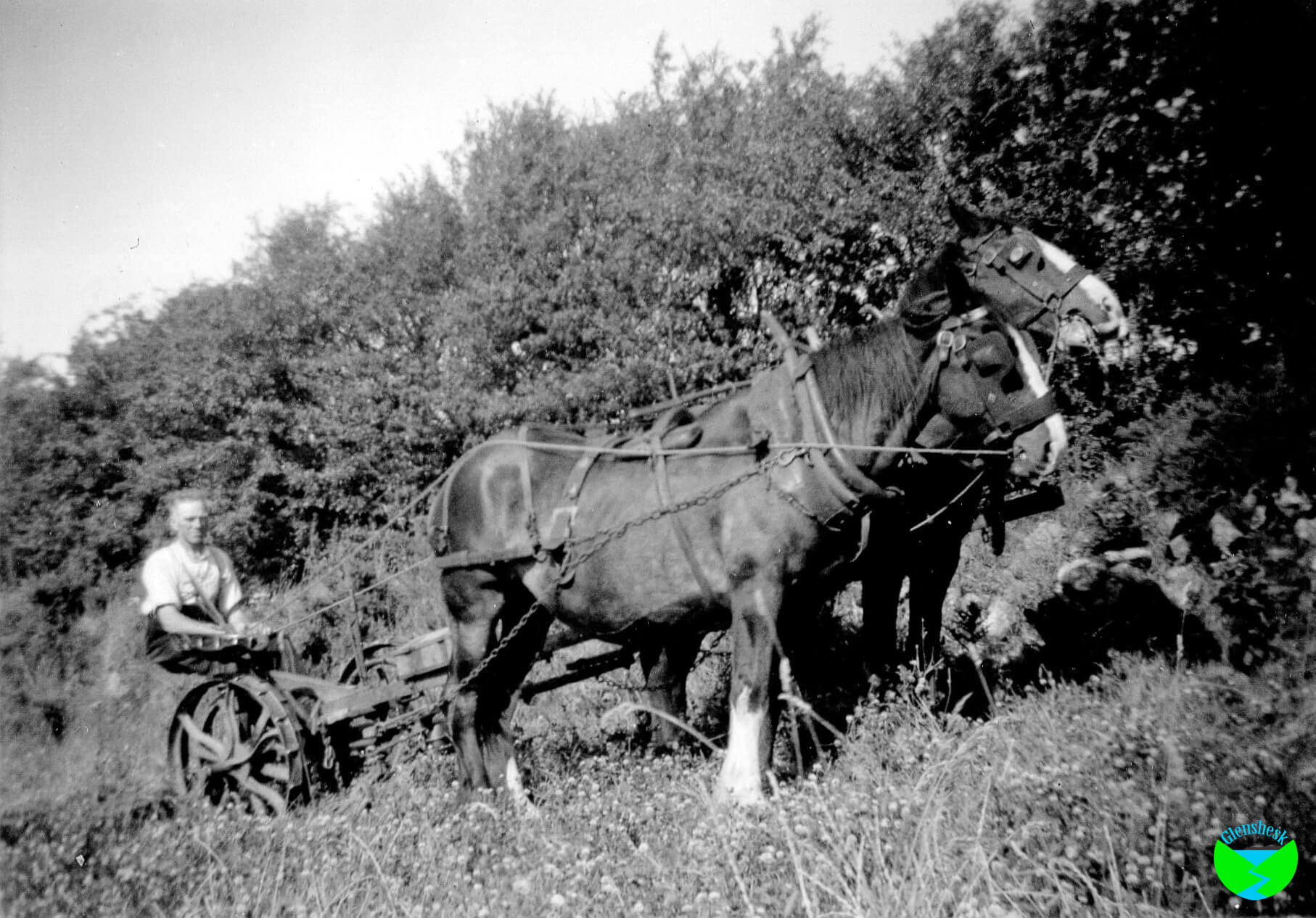
Horse Drawn Mower:
Here we have a nice photograph of a horse drawn mower at work on Duncarbit Farm, Glenshesk with two horses. The mower would have been used to cut crops.
Before the introduction of tractors, horses would have provided the main pulling power for all farm machinery, as well as also providing transport.
Turf cutting:
Before the introduction of coal, oil and gas for fuel, the main source of heat and for cooking was turf as well as wood. Most families had either their own turf banks or access to turf banks. Although it was great to have your own source of fuel, the work of producing turf was quite backbreaking. Turf was cut from the bank using a turf spade and taken on a turf barrow a short distance and then carefully laid on top of the heather on its side, and left to dry for a week or two. It could either be then turned or more likely “footed”, where groups of turf were placed in a wigwam shape for drying. This was backbreaking work, but when working with the turf and being remote from the farmhouse, the workers and families looked forward to the packed lunch which was a welcome break. Then a week or two later the footings could be placed into larger “clamps”. After a week or two the turf was then collected and put into a horse and cart, as in the attached photo from 1919, and later by tractor and trailer, and taken to the turf shed. Some early turf sheds in the Glen still process side openings (see photo) to allow for continued drying. It was said that the blacker the turf, the higher quality it was; brown turf didn’t burn well. In the 1970’s and 1980’s turf cutting machines were introduced into the Glen which cut into the bog removing the turf, which was then laid out several rows at a time like something that resembled long sausage; the machine was nicknamed the sausage machine.
During the digging of turf, other things were often dug up including bog oak, bog butter and in one case, an ancient breast chain mail. It was a large piece of bog oak which was given by Joseph Mc Bride of Loughan to Glenshesk man John Henry McAuley to start him off on his career as a wood Carver, before he penned “The Ould Lammas Fair”.
As other types of fuel became more readily available, the popularity of turf decreased, but during the 1970’s Glenshesk entrepreneur Billy Boylan of Tenaghs, produced turf on an industrial scale for sale.
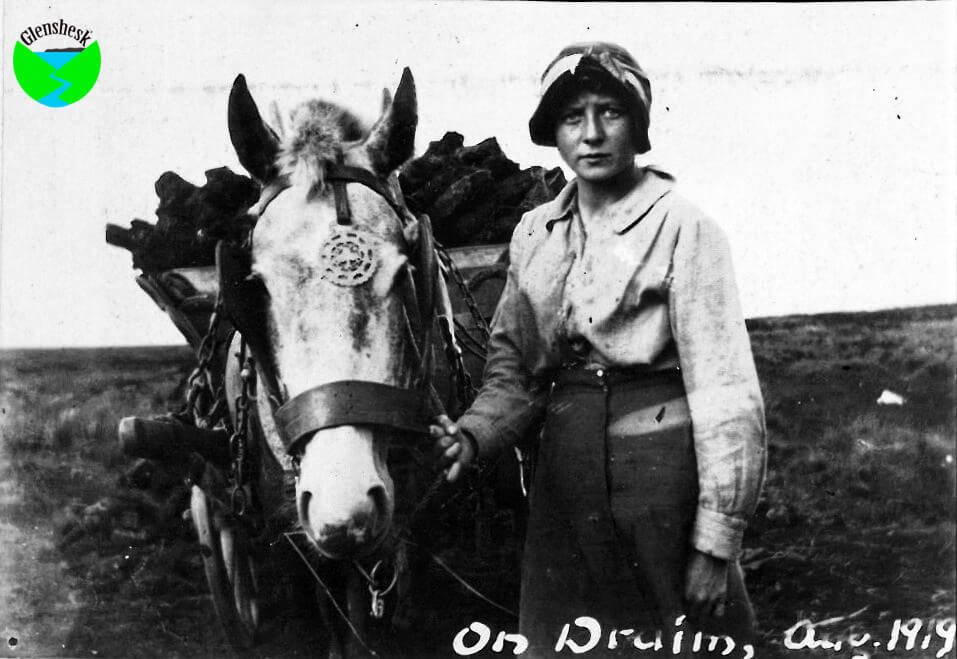
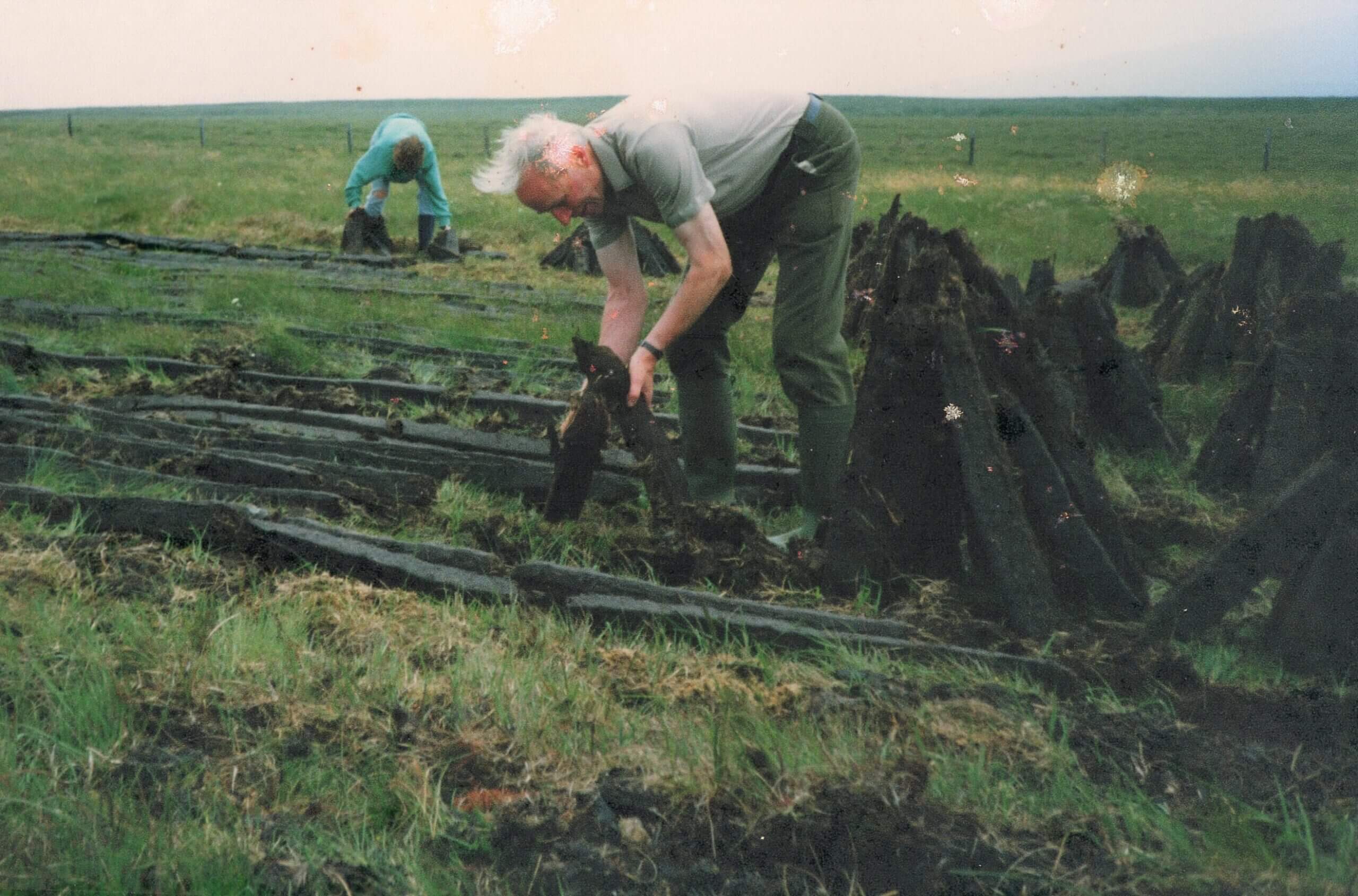



Ministry of Agriculture Trials:
During the 1950 – 1960’s, the Ministry of Agriculture in N.Ireland as part of their ongoing trials, partnered with some farmers in Glenshesk for various trials of new machinery as well as the growing of crops and dealing with weeds. On Clare braes (a steep hillside) they experimented with different methods of eradicating rushes which were a blight on the landscape, reducing grass areas considerably. In one experiment they ploughed one half of the steep brae numerous times to see if the growth of rushes decreased. The experiment seemed to work, and even today, if you look across from Glenview Road you can see a higher proportion of rushes on one side of the brae than the other.
Separately, the Ministry of Agriculture were involved in testing out new types of machinery and growing crops, and in the picture, we are not sure which it is they are doing, but we do understand that this was a Ministry of Agriculture trial of some sort. The location was the “Old Field” which then became known as the “Ministry Field”, on Duncarbit Farm in Glenshesk.

